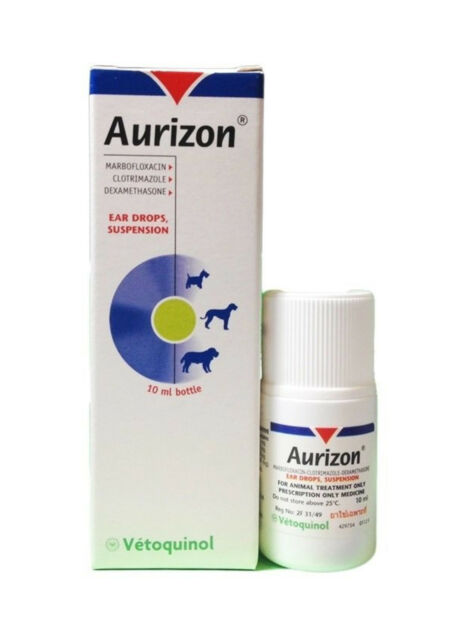Aurizon gouttes auriculaires pour chiens 10ml / gocce auriculaire per cani
Aurizon gouttes auriculaires pour chiens 10ml / gocce auriculaire per cani
1 ml d'AURIZON contient :
Marbofloxacine 3 mg,
Clotrimazole Ph. Eur 10 mg,
Acétate de dexaméthasone 1,0 mg,
(équivalent à la dexaméthasone 0,9 mg).
Liste des excipients : Gallate de propyle (E 310), Oléate de sorbitan, Silice colloïdale anhydre, Triglycérides à chaîne moyenne.
Il ne contient pas de conservateurs antimicrobiens.
Propriétés pharmacologiques :
La marbofloxacine est un agent bactéricide synthétique appartenant à la famille des fluoroquinolones et agissant comme inhibiteur de l'ADN gyrase. Elle présente un large spectre d'actions contre les bactéries Gram-positives (ex. Staphylococcus intermedius) et Gram-négatives (Pseudomonas aeruginosa, Escherichia coli et Proteus mirabilis). ) bactéries.
Le clotrimazole est un antifongique appartenant à la famille des imidazolés qui provoque des modifications de la perméabilité membranaire, permettant aux composants intracellulaires de diffuser dans l'espace extracellulaire, stoppant ainsi la synthèse moléculaire cellulaire. Il présente un large spectre, notamment contre Malassezia pachydermatis.
Acétate de dexaméthasone, glucocorticoïde synthétique à action anti-inflammatoire et antiprurigineuse.
Propriétés pharmacocinétiques :
Des études pharmacocinétiques chez le chien, concernant les doses thérapeutiques, ont montré ce qui suit :
- Les concentrations maximales de marbofloxacine dans le plasma atteignent jusqu'à 0,06 μg/ml au 14ème jour de traitement.
- La marbofloxacine se lie faiblement aux protéines plasmatiques (< 10 % chez le chien) et est éliminée lentement, surtout sous forme active, environ 2/3 dans les urines et 1/3 dans les fèces. L'absorption du clotrimazole est très faible (concentration plasmatique - La concentration plasmatique de l'acétate de dexaméthasone atteint 1,25 ng/ml au 14e jour de traitement).
- La résorption de la dexaméthasone n'est pas augmentée par le processus inflammatoire induit par l'otite.
Espèces cibles :
Chiens.
Indications :
Chez le chien : traitement des otites externes d'origine bactérienne ou fongique - respectivement causées par des bactéries sensibles à la marbofloxacine et des champignons sensibles au clotrimazole, en particulier Malassezia pachydermatis. Le produit doit être utilisé sur la base de tests de sensibilité.
Contre-indications :
Ne pas administrer aux chiens présentant une perforation du tympan. Ne pas administrer aux chiens présentant une hypersensibilité connue à l'un des ingrédients. Ne pas administrer aux femelles gestantes ou allaitantes.
Effets indésirables :
Des effets indésirables généralement associés aux corticostéroïdes peuvent survenir (modifications des paramètres biochimiques et hématologiques, telles qu'une augmentation de la phosphatase alcaline et de l'aminotransférase, neutrophilie). L'utilisation prolongée et intensive de préparations à base de corticostéroïdes topiques entraîne généralement des effets locaux et systémiques, notamment une suppression de la fonction des glandes surrénales, un épaississement de l'épiderme et un retard de cicatrisation des plaies. Dans de rares cas, l'utilisation de ce médicament a entraîné une diminution de l'acuité auditive, en particulier chez les chiens âgés, et dans la plupart des cas, il s'agit d'une diminution transitoire.
Précautions particulières d'emploi chez les animaux :
L'utilisation à long terme d'une seule classe d'antibiotiques peut induire une résistance dans une population bactérienne. L'utilisation de fluoroquinolones est recommandée dans le traitement des pathologies qui ont mal répondu ou devraient mal répondre à d'autres classes d'antibiotiques.
Le conduit auditif externe doit être soigneusement nettoyé et séché avant le traitement.
Avant d’utiliser le produit comme traitement, l’intégrité de la membrane tympanique doit être vérifiée.
Eviter tout type de contamination lors de l'utilisation.
Caractéristiques du produit
Caractéristiques du produit
Matériaux et entretien
Matériaux et entretien
Conseils de marchandisage
Conseils de marchandisage
Partager

